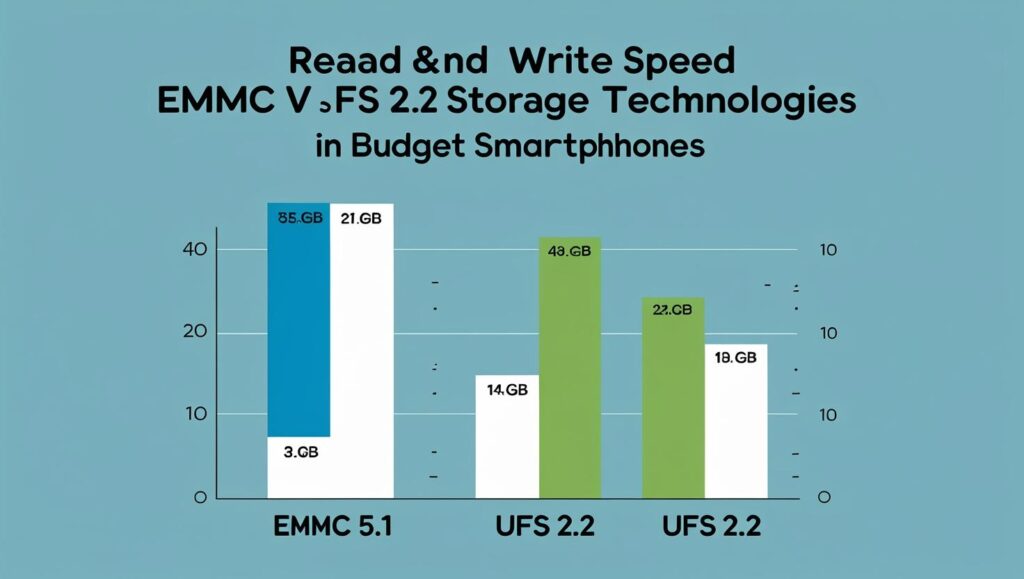When you’re shopping for a new budget smartphone, you’re likely focused on the screen size, camera megapixels, and battery life. But hidden deep within the spec sheet is a component that has a far greater impact on your daily experience: the storage type.
The choice between eMMC 5.1 and the more modern UFS 2.2 is the single most important factor determining how fast your phone feels, not just on day one, but for years to come. This isn’t just about benchmarks; it’s about the fundamental architecture that dictates everything from app cold-install speeds to multitasking fluidity.
In this ultimate deep-dive, we go beyond the numbers to explore the architectural divide, the science of slowdown, and the real-world impact of these two technologies, so you can make an informed decision and avoid the frustration of a laggy device.
eMMC 5.1 vs UFS 2.2
The Ultimate Deep Dive. Beyond benchmarks, we uncover the architectural truths that determine your phone's long-term speed and stability.
The Architectural Divide
The performance gap isn't just about speed; it's a fundamental difference in how data is managed. UFS is a modern parallel-processing system, while eMMC is a single-file line.
eMMC 5.1 Half-Duplex
Operates on a one-way data bus. It can either READ or WRITE, but never both simultaneously. This creates a bottleneck, causing stutters when the phone is multitasking.
ONE OPERATION AT A TIME
UFS 2.2 Full-Duplex
Uses separate, dedicated lanes for reading and writing. This allows simultaneous operations, eliminating bottlenecks for a smooth, responsive experience.
SIMULTANEOUS READ & WRITE
The Real Difference: Command Queuing
eMMC 5.1: FIFO Buffer
eMMC has a simple "First-In, First-Out" queue. It processes commands one by one, in the order they arrive. It cannot re-order tasks for efficiency.
UFS 2.2: Tagged Command Queuing (TCQ)
UFS uses the powerful SCSI architecture to analyze a batch of commands, intelligently reorder them, and execute them in parallel for maximum efficiency. This is the secret to its "SSD-like" random access speed.
The Science of Slowdown
Ever wonder why your phone gets laggy over time? The answer lies in a hidden process called Write Amplification, a problem far more severe on eMMC storage.
Write Amplification: The Hidden Performance Killer
NAND flash memory can't just overwrite a small piece of data. To change even a tiny file, the controller must perform an inefficient **Read-Modify-Write cycle**. This means a small logical request from the OS results in a much larger physical write to the storage, causing accelerated wear and tear.
A Typical eMMC Write Cycle:
1. Host Request
Change 4KB of data.
2. Read
Controller reads a large 16MB block.
3. Modify & Write
Controller writes the entire 16MB block to a new location.
Can Software Fix Slow Hardware?
Some brands claim OS optimizations can make slower storage feel faster. While clever caching and file management can help with simple tasks, software **cannot** fix fundamental hardware limitations. It cannot create a full-duplex path where one doesn't exist, nor can it grant an eMMC controller the ability to reorder commands like UFS. During heavy multitasking or sustained workloads, the hardware bottleneck will always reveal itself.
Real-World Performance
We translate the theory into tangible results, showing how these technologies perform in everyday tasks and in head-to-head device comparisons.
Typical Performance Metrics
Case Study: Xiaomi Redmi 12 Series
This device family provides a perfect real-world comparison. The standard Redmi 12 uses a MediaTek SoC with eMMC 5.1, while the Redmi 12 5G uses a Snapdragon SoC with UFS 2.2. Despite similar pricing, the performance difference is stark.
Redmi 12 (eMMC 5.1)
- Noticeably slower app installs and loading.
- Stutter during heavy multitasking.
- Lower synthetic benchmark scores (AnTuTu ~253k).
- Feels adequate for basic tasks, but struggles under load.
Redmi 12 5G (UFS 2.2)
- Significantly faster app and system performance.
- Smooth, fluid multitasking.
- Much higher benchmark scores (AnTuTu ~445k).
- Provides a superior, more future-proof user experience.
The Manufacturer's Dilemma
If UFS is so much better, why does eMMC still exist? The answer lies in the razor-thin margins of the budget smartphone market.
The Cost vs. Experience Equation
eMMC 5.1's only remaining advantage is its rock-bottom price. For manufacturers building phones for the sub-$125 "ultra-budget" segment, every fraction of a cent on the Bill of Materials (BOM) counts. Using eMMC allows them to hit these aggressive price points.
However, for any device above this tier, UFS 2.2 has become the de facto standard. Manufacturers use it as a key differentiator to signal a quality, durable user experience. The small increase in BOM cost is justified by a massive leap in performance and customer satisfaction.
| Phone Model | Storage Type | Approx. Price (USD) |
|---|---|---|
| Xiaomi Redmi 12C | eMMC 5.1 | $110 |
| Samsung Galaxy A05s | eMMC 5.1 | $124 |
| Xiaomi Redmi 12 5G | UFS 2.2 | $130+ |
| Moto G54 5G | UFS 2.2 | $190 |
| Poco M6 Pro | UFS 2.2 | $200+ |
The Verdict
The evidence is overwhelming. For a fast, fluid, and future-proof smartphone, UFS 2.2 is the superior technology and the recommended baseline. While eMMC 5.1 serves the ultra-budget market, it comes with significant performance compromises that become more apparent over time. When buying your next phone, look for "UFS 2.2" on the spec sheet. It's one of the most important upgrades you can get for your money.
